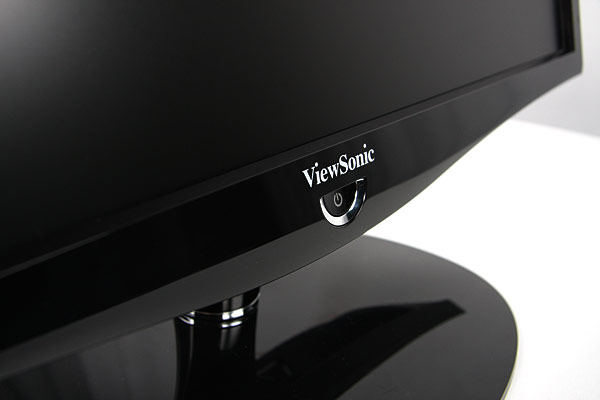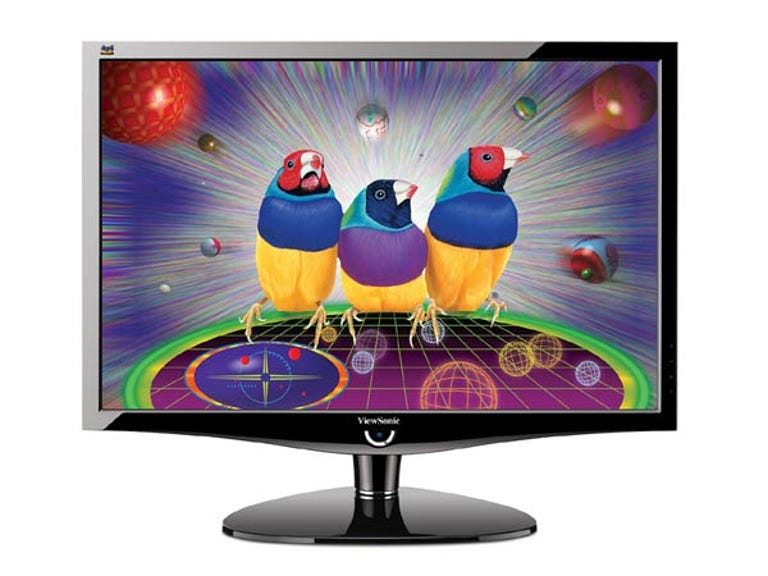 Why You Can Trust CNET
Why You Can Trust CNET ViewSonic VX2237wm review: ViewSonic VX2237wm
The VX2237wm is passable considering its price range, but you can get better for cheaper if you don't need the speakers.
Like a lot of consumer products these days, ViewSonic's VX2237wm is shiny in an "oh look at the dust and fingerprints" kind of way. The piano-black, 22-inch screen is mostly gloss except for the rear of the monitor and the panel itself, which ViewSonic has wisely kept matte.
The Good
The Bad
The Bottom Line
It feels a little retro with the curve at the bottom of the screen, the plectrum-shaped base and the chrome-enshrined, indented power button under ViewSonic's serif font; but it's also minimalist. The only other item of note is the requisite Gouldian finches logo in the top left.
Being a 22-inch monitor, it's part of what is quickly becoming an old breed; 21.5- and 23-inch screens with resolutions of 1920x1080 seem to be the new "thing", with the older 16:10 aspect ratio monitors slowly being phased out. That's not to say the VX2237wm doesn't have anything to offer — let's take it for a lap and see what it brings to the race.

Chrome, black and curves lend the VX2237wm a retro feel. (Credit: Craig Simms/CBS Interactive)
| Size | 22 inches |
|---|---|
| Resolution | 1680x1050 |
| Aspect ratio | 16:10 |
| Pixel pitch | 0.282 |
| Panel technology | TN |
| Viewing angles (10:1 contrast) | H: 170° V: 160° |
| Response time | 5ms G2G |
| Max vertical refresh | 76Hz |
| Connections | DVI, VGA |
| Accessories | DVI, VGA, power cables |
ViewSonic's base has the opportunity to put in a swivel option but fails to do so, opting instead to provide the standard tilt only. The thin neck surprisingly doesn't cause too much of a stability issue, although you may notice a slight wobble while typing.
One shiny dust and hair collector, check.
(Credit: Craig Simms/CBS Interactive)
Power, 3.5mm audio in, DVI and VGA connections. (Credit: Craig Simms/CBS Interactive)
Packing a pair of 2W speakers, ViewSonic has taken a small step above the usual 1.5W affairs. While this means a lot of the tinniness often associated with monitor speakers is overcome, it's completely defeated by the rear/upper firing of the cones, meaning you actually have to be looking at the back of this monitor to get the best quality sound out of it — not so helpful.
Buttons and on-screen display (OSD)
All this front-facing cleanliness can only mean one thing: the evil of side buttons. While ViewSonic has put labels on the right-hand side to try and help show what's what, they're indented in the piano-black surface, making them almost impossible to see in the light, let alone the dark.
Unlike Dell and Acer, which somewhat mitigate the effect by allowing you to fumble for any old button that brings up a menu, then show visually in the OSD where the buttons are and what each one does, ViewSonic has given each button a dedicated function, and the menu appears in the middle of the screen. Be prepared to memorise the order of the buttons and play a bit of button Braille at first, but soon it will all become second nature.
Side buttons! Why'd it have to be side buttons? (Credit: Craig Simms/CBS Interactive)
ViewSonic has updated its aging OSD on the VX2237wm, with the new menu appearing clean, simple and not looking like it escaped a 90's CRT. Mostly there are only basic image adjustments; however, ViewSonic has included an "Eco" mode as well. All this does is adjust brightness, and there's no "walk away" proximity sensors like the Philips Brilliance 225B — so if you're really concerned about being eco conscious, we recommend you simply keep the brightness low all the time.
Refreshingly, there's not a preset in sight — simply 5000K, 6500K, 7500K, 9300K, sRGB and User Color modes. Unfortunately, there are no scaling options either, the user being forced to stretch to full screen.
ViewSonic's redesigned menu is straightforward. (Screenshot by Craig Simms/CBS Interactive)
Lagom.nl LCD tests
After calibrating to a target brightness of 140cd/m² with an X-Rite i1Display 2, Eye-One Match 3 and tweaking with HCFR, the VX2237wm was run through the Lagom.nl LCD tests.
| Image tests | |||||
|---|---|---|---|---|---|
| Contrast | Sharpness | Gamma | Black level | White saturation | Gradient |
| Pass | Pass | Pass | Cannot differentiate shade 1 from background | Pass | Pass |
| Inversion pixel walk tests | ||||||||||
|---|---|---|---|---|---|---|---|---|---|---|
| Test 1 | Test 2a | Test 2b | Test 3 | Test 4a | Test 4b | Test 5 | Test 6a | Test 6b | Test 7a | Test 7b |
| Pass | Pass | Flicker | Slight flicker | Pass | Flicker | Pass | Pass | Pass | Pass | Pass |
It's been a while since we've seen something fail the black level test under calibrated conditions. You can get the bottom black to show by completely ramping the brightness and colours, but then, that's defeating the purpose.
Input lag
Measured against a Samsung SyncMaster 975p CRT, and using a Canon 40D set to a shutter speed of 1/320, an average of over 60 photographs were taken using Virtual Stopwatch Pro. The average result over DVI came in as 2.88ms, meaning almost no input lag. The largest difference measured between the two screens was 32ms, although the vast majority were simply zeroes.
Colour accuracy
ΔE is the measurement of how far a measured colour deviates from its expected value, allowing us to determine the colour accuracy of a monitor. While a ΔE value of 1 is considered perceivable, as long as it's less than 3 the shift shouldn't be too obvious. HCFR was used to determine ΔE for the monitor.
| Measured levels | |
|---|---|
| Contrast ratio | 900:1 |
| Black level (cd/m²) | 0.34 |
| White level (cd/m²) | 306.22 |
| Gamma | 1.98 |
| Greyscale ΔE | ||||||||||
|---|---|---|---|---|---|---|---|---|---|---|
| 0% | 10% | 20% | 30% | 40% | 50% | 60% | 70% | 80% | 90% | 100% |
| 77.1 | 17.9 | 17.7 | 15.7 | 15.0 | 14.2 | 13.4 | 12.1 | 11.3 | 10.4 | 9.4 |
| Colour ΔE | |||||
|---|---|---|---|---|---|
| Red | Green | Blue | Yellow | Cyan | Magenta |
| 8.0 | 2.6 | 6.7 | 2.0 | 10.1 | 12.3 |
The uncalibrated CIE chart. The white triangle is the colour space of the monitor, the dark is the sRGB gamut it's trying to match. (Screenshot by CBS Interactive)
Whew, that's quite a bit off, even for an uncalibrated screen. Let's see what we can do to at least fix the greyscales.
| Measured levels | |
|---|---|
| Contrast ratio | 946:1 |
| Black level (cd/m²) | 0.15 |
| White level (cd/m², target 140cd/m²) | 141.97 |
| Gamma (target 2.2) | 2.21 |
| Greyscale ΔE | ||||||||||
|---|---|---|---|---|---|---|---|---|---|---|
| 0% | 10% | 20% | 30% | 40% | 50% | 60% | 70% | 80% | 90% | 100% |
| 78.7 | 10.9 | 2.0 | 1.0 | 0.6 | 1.6 | 1.6 | 1.2 | 1.7 | 1.2 | 1.6 |
| Colour ΔE | |||||
|---|---|---|---|---|---|
| Red | Green | Blue | Yellow | Cyan | Magenta |
| 7.3 | 3.8 | 6.5 | 7.6 | 5.5 | 9.6 |
The calibrated CIE chart (Screenshot by CBS Interactive)
Definitely better on the greys, even if the bottom end loses it a bit. Unfortunately, this is as good as it gets for the VX2237wm — as an entry-level monitor it doesn't have too many controls to further correct this.
Viewing angles
Viewing angles were taken with a Canon 40D in spot metering mode, with only shutter time adjusted to obtain a good exposure.
Typical TN viewing angles are demonstrated by the VX2237wm. (Credit: Craig Simms/CBS Interactive)
Backlight uniformity
Backlight uniformity was measured by placing HCFR into free measure mode, displaying a completely white image and recording the brightness along a 5x3 grid on the screen. This should be considered a guide only, as backlight uniformity is likely to change from unit to unit.
Nothing amazingly out of the ordinary, except that bottom right section which is brighter than one would expect. (Credit: Craig Simms/CBS Interactive)
Light bleed
There is visible light bleed from all sides of the VX2237wm. This is particularly bad — usually it's limited to the top and bottom.
It's important to note that the effects of light bleed will likely change from monitor to monitor, regardless of make.
Other issues
The panel itself is quite deeply inset, and the bezel is piano black, meaning that during bright scenes you may notice the screen's reflection on the bezel, which will be distracting for some.
Power consumption
We measured power consumption using a Jaycar mains digital power meter. It's important to note here that due to limitations of the meter, measurements are limited to values of 1W and greater, and are reported in 1W increments.
All measurements, screen brightness and contrast were set to 100 per cent, and a test image displayed.
| Juice Box |  |
|---|---|
| Maximum power draw | 37W |
| Power-saving mode | 7W |
| Off | 7W |
It doesn't pull as much as Acer's G225HQ, but it's not far off. There's definitely more efficient monitors available.
ViewSonic offers a three-year warranty for its LCD products. If you have a bright or dark subpixel, you may return the monitor to the reseller up to 30 days from the date of purchase. After the 30 days DOA guarantee, things get a little murkier. The tolerance levels are outlined in the diagram below:
Inside area 1, one dead pixel is required for swap out. In area 2, 3, 4 and 5, you'll need two dead pixels to get a replacement, and sections 6, 7, 8 and 9 will need three before ViewSonic will replace your monitor. (Credit: ViewSonic)
The VX2237wm is passable considering its price range, but you can get better for cheaper if you don't need the speakers. Those with basic monitor needs would do better to check out Acer's G225HQ.


